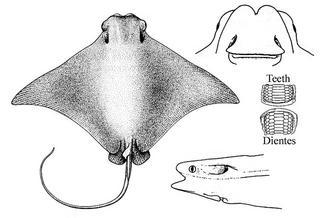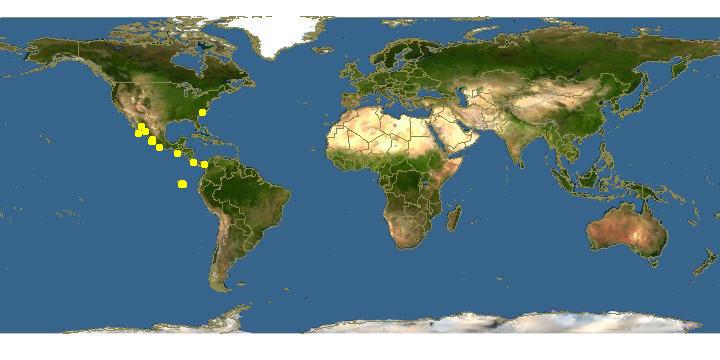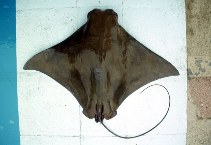
www.fao.org Copyright Michel Lamboeuf · 0
Rhinoptera steindachneri |

Click on map for details about points.
|
| Links |
We parsed the following live from the Web into this page. Such content is managed by its original site and not cached on Discover Life. Please send feedback and corrections directly to the source. See original regarding copyrights and terms of use.
- FishBase
|
|
español |
|
|
Overview |
Main identification features
- disc rhomboidal, width greater than length
- golden brown
- tail slender, + spines
- head large, square, flaps and notch at front
Golden cownose-ray, Pacific cownose-ray, Hawkray
A diamond-shaped ray with head distinctly protruding from disc; head with "wings" along side and front; teeth in 6-9 plates in top and bottom; width of disc about 1.7-1.8 times its length; tail with 1-2 serrated spines, their length about 2.5 times eye width; tail very slender, about 1.2-1.6 times length of disc; skin smooth.
Overall pale yellowish brown, white on ventral surface; tail blackish.
Grows to about 104 cm disc width.
Inhabits coastal lagoons, often forms large schools in mangrove areas.
Depth: to 30 m.
Central Baja and the Gulf of California to Peru, the Galapagos and Malpelo.
Attributes
Abundance: Common.
Cites: Not listed.
Climate Zone: Northern Subtropical (Cortez Province + Sinaloan Gap); Northern Tropical (Mexican Province to Nicaragua + Revillagigedos); Equatorial (Costa Rica to Ecuador + Galapagos, Clipperton, Cocos, Malpelo); South Temperate (Peruvian Province ); North Temperate (Californian Province &/or Northern Gulf of California).
Depth Range Max: 30 m.
Depth Range Min: 0 m.
Diet: mobile benthic crustacea (shrimps/crabs); mobile benthic gastropods/bivalves.
Eastern Pacific Range: Northern limit=32; Southern limit=-6; Western limit=-115; Eastern limit=-78; Latitudinal range=38; Longitudinal range=37.
Egg Type: Live birth; No pelagic larva; No pelagic phase.
Feeding Group: Carnivore.
FishBase Habitat: Reef Associated.
Global Endemism: Tropical Eastern Pacific (TEP) endemic; East Pacific endemic; All species.
Habitat: Beach; Estuary; Mud; Sand & gravel; Soft bottom only; Soft bottom (mud, sand,gravel, beach, estuary & mangrove).
Inshore Offshore: Inshore; Inshore Only.
IUCN Red List: Not evaluated / Listed.
Length Max: 104 cm.
Regional Endemism: Island (s); Continent; Continent + Island (s); TEP endemic; All species.
Residency: Resident.
Salinity: Brackish; Marine.
Water Column Position: Bottom; Mid Water; Near Bottom; Near Surface; Surface; Bottom + water column;
|
|
|
Names | |
|
|
|
Links to other sites | |
|
|
|
References |
- Acero , A. and Franke, R., 1995., Nuevos registros de peces cartilaginosos del Parque Nacional Natural Gorgona (Pacifico Colombiano), II. Rayas y Descripcion de una Nueva Especie., Bibl. J. J. Triana, 11:9-21.
- Acero, A. and Franke, R., 2001., Peces del parque nacional natural Gorgona. En: Barrios, L. M. y M. Lopéz-Victoria (Eds.). Gorgona marina: Contribución al conocimiento de una isla única., INVEMAR, Serie Publicaciones Especiales No. 7:123-131.
- Beebe , W. and Tee-Van, J., 1941., Eastern Pacific expeditions of the New York Zoological Society. XXVIII. Fishes from the tropical eastern Pacific. (From Cedros Island, Lower California, South to the Galápagos Islands and northern Peru.) Part 3. Rays, mantas and chimaeras., Zoologica, 26(3):245-280.
- Breder, C.M. Jr., 1928., Scientific results of the second oceanographic expedition of the "Pawnee" 1926. Elasmobranchii from Panama to Lower California., Bull. Bingham Oceanogr. Collect. Yale Univ., 2(1):1-13.
- Béarez, P., 1996., Lista de los Peces Marinos del Ecuador Continental., Revista de Biologia Tropical, 44:731-741.
- Castri-Aguirre, J.L., Espinoza-Pérez, H. and Schmitter-Soto, J.J., 2002., Lista sitemática, biogeográfica y ecológica de la ictiofauna estuarino lagunar y vicaria de México. En: Lozano-Vilano, M. L. (Ed.). Libro Jubilar en Honor al Dr. Salvador Contreras Balderas., Universidad Autonoma de Nuevo León:117-142.
- Castro-Aguirre, J.L., 1999., Ictiofauna estuarino-lagunar y vicaria de México., Editorial Limusa S.A. de C.V.: 1-629pp.
- Compagno, L.J.V., 1999., Checklist of living elasmobranchs. In Hamlett W.C. (ed.) Sharks, skates, and rays: the biology of elasmobranch fishes., The John Hopkins University Press:471-498.
- De la Cruz , J. , Galvan , F. , Abitia , L. A. , Rodriguez , J. and Gutierrez, F. J., 1994., Lista sistematica de los peces marinos de Bahia Magdalena, Baja California Sur (Mexico). Systematic List of marine fishes from Bahia Magdalena, Baja California Sur (Mexico)., Ciencias Marinas, 20:17-31.
- Evermann , B.W. and Jenkins, O.P., 1891., Report upon a collection of fishes made at Guaymas, Sonora, Mexico, with descriptions of new species., Proc. U.S. Nat. Mus., 14:121-165.
- Findley, L.T., Hendrickx, M.E., Brusca, R.C., van der Heiden, A.M., Hastings, P.A., Torre, J., 2003., Diversidad de la Macrofauna Marina del Golfo de California, Mexico., CD-ROM versión 1.0. Projecto de la Macrofauna del Golfo . Derechos reservados de los autores y Conservación Internacional.
- Fowler, H.W., 1916., Cold-Blooded Vertebrates from Costa Rica and the Canal Zone., Proc. Acad. Nat. Sci. Phila., 68:389-414.
- Galván-Magaña, F., Gutiérrez-Sánchez, F., Abitia-Cárdenas, L.A., Rodríguez-Romero, J., 2000., The distribution and affinities of the shore fishes of the Baja California Sur lagoons. In Aquatic Ecosystems of Mexico: Status and Scope. Eds. M. Manuwar, S.G. Lawrence, I.F. Manuwar & D.F. Malley. Ecovision World Monograph Series., Backhuys Publishers:383-398.
- Humann, P., 1993., Reef Fish Identification: Galapagos., New World Publishing:192pp.
- Jimenez-Prado, P., Béarez, P., 2004., Peces marinos del Ecuador continental / Marine fishes of continental Ecuador., SIMBIOE/NAZCA/IFEA tomo 1 y 2.
- Jordan , D.S. and Evermann, B.W., 1896., The fishes of North and Middle America: a descriptive catalogue of the species of fish-like vertebrates found in the waters of North America, north of the Isthmus of Panama. Part I., Bull. U.S. Nat. Mus., 47:1-1240.
- Lopez , M. I. and Bussing, W. A., 1982., Lista provisional de los peces marinos de la Costa Rica., Revista de Biologia Tropical, 30(1):5-26.
- Love, M.S., Mecklenburg, C.W., Mecklenburg, T.A., Thorsteinson, L.K., 2005., es of the West Coast and Alaska: a checklist of North Pacific and Artic Ocena species from Baja California to the Alaska-Yukon border., U.S. Department of the Interior, U.S. Geological Survey, Biological Resources Division, 288pp.
- Minckley, W.L., 2002., Fishes of the lowermost colorado river, its delta, and estuary: a commentary on biotic change. En: Lozano-Vilano, M. L. (Ed.). Libro Jubilar en Honor al Dr. Salvador Contreras Balderas., Universidad Autonoma de Nuevo León:63-78.
- Van der Heiden , A. M. and Findley, L. T., 1988., Lista de los peces marinos del sur de Sinaloa, México., Anales del Centro de Ciencias del Mar y Limnologia de la Universidad Autonoma Nacional de Mexico, 15:209-224.
|
|
|
Acknowledgements | |
I thank Ashley MacDonald and John Pickering, University of Georgia, for technical support in building this page.
|
|
| Supported by | |
|
Following modified from FishBase
|
Top | See original
http://www.fishbase.org/Summary/speciesSummary.php?genusname=Rhinoptera&speciesname=steindachneri ---> http://192.134.151.83/Summary/speciesSummary.php?genusname=Rhinoptera&speciesname=steindachneri
http://192.134.151.83/Summary/speciesSummary.php?genusname=Rhinoptera&speciesname=steindachneri ---> https://fishbase.mnhn.fr/Summary/speciesSummary.php?genusname=Rhinoptera&speciesname=steindachneri
https://fishbase.mnhn.fr/Summary/speciesSummary.php?genusname=Rhinoptera&speciesname=steindachneri ---> https://fishbase.mnhn.fr/summary/Rhinoptera-steindachneri.html
Rhinoptera steindachneri, Pacific cownose ray : aquarium

You can
sponsor
this page
Common name (e.g. trout)
Genus + Species (e.g. Gadus morhua)
-

-
About this page
-
Languages
-
User feedbacks
-
Citation
-
Uploads
-
Related species
-


 Pacific cownose ray
Add your observation in
Fish Watcher
Upload your
photos
and
videos
Pacific cownose ray
Add your observation in
Fish Watcher
Upload your
photos
and
videos
Pictures
|
Google image
 Rhinoptera steindachneri
Rhinoptera steindachneri
Picture by
Béarez, P.
Elasmobranchii (sharks and rays) >
Myliobatiformes
(Stingrays) >
Rhinopteridae
(Cownose rays)
Etymology:
Rhinoptera:
Greek, rhinos = nose + Greek,pteron = fin, wing (Ref.
45335
)
.
More on authors:
Evermann
&
Jenkins
.
Environment: milieu / climate zone / depth range / distribution range
Ecology
Marine; reef-associated; oceanodromous (Ref.
51243
); depth range 0 - 65 m (Ref.
117244
), usually 0 - 25 m. Tropical; 32°N - 5°S, 117°W - 76°W
Eastern Pacific: Gulf of California to Costa Rica and the Galapagos Islands. Probably occurring elsewhere.
Length at first maturity / Size / Weight / Age
Maturity: L
m
71.0
, range 65 - ? cm
Max length : 91.6 cm WD male/unsexed; (Ref.
116975
)
Adults are found over soft bottoms, near rocky or coral reefs; also near reef drop-offs (Ref.
12951
). They occasionally swim near the surface and may jump out of the water. Often in schools, sometimes associated with
Aetobatus narinari
, the spotted eagle ray (Ref.
12951
). Adults feed on benthic crustaceans and mollusks. Ovoviviparous (Ref.
50449
).
Exhibit ovoviparity (aplacental viviparity), with embryos feeding initially on yolk, then receiving additional nourishment from the mother by indirect absorption of uterine fluid enriched with mucus, fat or protein through specialised structures (Ref.
50449
).
McEachran, J.D. and G. Notarbartolo di Sciara
, 1995. Rhinopteridae. Gavilanes. p. 782-783. In W. Fischer, F. Krupp, W. Schneider, C. Sommer, K.E. Carpenter and V. Niem (eds.) Guia FAO para Identification de Especies para los Fines de la Pesca. Pacifico Centro-Oriental. 3 Vols. FAO, Rome. (Ref.
9263
)
IUCN Red List Status (Ref.
130435
)
Near Threatened (NT)
(A2d); Date assessed:
08 February 2019
CITES
Not Evaluated
Not Evaluated
Threat to humans
Harmless
Human uses
Fisheries: of no interest; aquarium: public aquariums
FAO - Publication:
search
|
FishSource
|
More information
Countries
FAO areas
Ecosystems
Occurrences
Introductions
Stocks
Ecology
Diet
Food items
Food consumption
Ration
Common names
Synonyms
Metabolism
Predators
Ecotoxicology
Reproduction
Maturity
Spawning
Spawning aggregation
Fecundity
Eggs
Egg development
Age/Size
Growth
Length-weight
Length-length
Length-frequencies
Morphometrics
Morphology
Larvae
Larval dynamics
Recruitment
Abundance
BRUVS
References
Aquaculture
Aquaculture profile
Strains
Genetics
Electrophoreses
Heritability
Diseases
Processing
Nutrients
Mass conversion
Collaborators
Pictures
Stamps, Coins Misc.
Sounds
Ciguatera
Speed
Swim. type
Gill area
Otoliths
Brains
Vision
Tools
E-book
|
Field guide
|
Length-frequency wizard
|
Life-history tool
|
Point map
|
Classification Tree
|
Catch-MSY
|
Special reports
Check for Aquarium maintenance
|
Check for Species Fact Sheets
|
Check for Aquaculture Fact Sheets
Download XML
Summary page
|
Point data
|
Common names
|
Photos
Internet sources
AFORO (otoliths) |
Aquatic Commons
|
BHL
|
Cloffa
|
BOLDSystems
|
Websites from users
|
Check FishWatcher
|
CISTI
|
Catalog of Fishes
:
genus
,
species
|
DiscoverLife
|
ECOTOX
| FAO - Publication:
search
|
Faunafri
| Fishipedia |
Fishtrace
| GenBank:
genome
,
nucleotide
|
GloBI
|
Google Books
|
Google Scholar
|
Google
| IGFA World Record |
MitoFish
|
Otolith Atlas of Taiwan Fishes
|
PubMed
|
Reef Life Survey
| Socotra Atlas |
Tree of Life
| Wikipedia:
Go
,
Search
| World Records Freshwater Fishing |
Zoobank
|
Zoological Record
Estimates based on models
Preferred temperature (Ref.
123201
): 19.7 - 29.1, mean 24.2 °C (based on 266 cells).
Phylogenetic diversity index (Ref.
82804
): PD
50
= 0.5039 [Uniqueness, from 0.5 = low to 2.0 = high].
Bayesian length-weight: a=0.01148 (0.00463 - 0.02844), b=2.98 (2.76 - 3.20), in cm total length, based on LWR estimates for this (Sub)family-body shape (Ref.
93245
).
Trophic level (Ref.
69278
): 3.6 ±0.50 se; based on food items.
Generation time: 4.4 ( na - na) years. Estimated as median ln(3)/K based on 1
growth studies.
Resilience (Ref.
120179
): Very Low, minimum population doubling time more than 14 years (k = 0.25; tmax = 10.75; tm = 3.92; Fec = 1).
Fishing Vulnerability (Ref.
59153
): Moderate to high vulnerability (50 of 100).
Nutrients (Ref.
124155
): Calcium = 7.27 [0.83, 109.36] mg/100g; Iron = 0.396 [0.033, 4.161] mg/100g; Protein = 20.6 [15.3, 25.9] %; Omega3 = 0.0736 [, ] g/100g; Selenium = 29 [6, 147] μg/100g; VitaminA = 30.9 [2.6, 334.1] μg/100g; Zinc = 0.769 [0.049, 8.696] mg/100g (wet weight);
Back to Search
Random Species
Back to Top
Accessed through:
Not available
FishBase mirror site :
localhost
Page last modified by :
mrius-barile
- 20 July 2016
Fatal error
: Uncaught ArgumentCountError: Too few arguments to function checkEcotox(), 1 passed in /var/www/html/summary/speciessummary.php on line 2304 and exactly 3 expected in /var/www/html/includes/speciessummary.lib.php:2579 Stack trace: #0 /var/www/html/summary/speciessummary.php(2304): checkEcotox() #1 {main} thrown in
/var/www/html/includes/speciessummary.lib.php
on line
2579
|
Updated: 2024-04-23 08:47:45 gmt
|